9
A Walk in the Park
One Sunday in September 1893 at around six-thirty in the evening, George Moore decided to walk across St James’s Park to find a place to eat (Fig. 102). A coster woman was noisily chastising her daughter as he entered the park and he hurried on until all of a sudden his attention was grasped by ‘landscape beauty more exquisite than any I had yet seen’.1 In the pale sunlight, the trees, suspended over the ‘green sward’, seemed to ‘speak like a memory’. Moore recognized the scene as a ‘beautiful Watteau’. Without difficulty the glade was peopled with Watteau’s characters – Pierrot leans over a lady ‘twanging a guitar’. At that moment, the eighteenth century lurked beneath the surface of reality. What Moore saw was not the real trees of St James’s but Une assemblée dans le parc (Fig. 103), a painting in the Louvre he half remembered.2 The picture was a memory of an object which existed elsewhere. In a London often characterized in the 1890s for its grimness, this momentary glimpse of Elysium was not insignificant. The ghost of Watteau, which continued to haunt the social elite of the belle époque, had made a sudden appearance in St James’s.
This chapter is concerned with the degree to which a coherent understanding of French eighteenth-century visual culture impacted upon British painting at the turn of the century. At a crude level it is about the consumption of an alternative, foreign visual code and the way in which consumption itself becomes a new form of production.3 It takes as given the background debates about Englishness and the rural. Central to this investigation is the shared understanding of the mind’s process of moving between matter and memory – ideas which around the turn of the century would become popularly associated with Henri Bergson. The dialogue of realities, between the perception of the external world and the life of the mind, was essential to the conceptualization of the art-making process. Henry Tonics recalled a fellow painter, Charles Wellington Furse, telling him around this time that imagination was memory.4 Allied to this were ideas about style and modernity drawing upon a common visual repository, upon recollections which privileged pre-Revolutionary France. La moderne, crucially dependent upon the fickle face of the manners and dress of the time, had its roots in a way of seeing, in social and philosophical attitudes, which were fused initially, in Moore’s mind, with Impressionism – although within a short time something more was demanded. The fashionable world performed a kind of comédie. It was not disorganized. It arranged itself in front of him, as he walked through the park.5 Moore’s vision entailed the admission of sensual delight, of a landscape improved by artifice – a setting more readily found in St James’s than in Hyde Park or Green Park, but which paled beside the Tuileries, the Luxembourg or Versailles.6 In this transformed landscape he envisioned a world in which men were constrained by the rules of gallantry and courtship and women were permitted the exercise of caprice. Its surfaces, its ‘satin and sunset … its ankles and epigrams’, composed themselves agreeably within the frame of a picture.7 To get there he must hurry past the coster, a clinging symbol of present reality.
Moore was not the first British late nineteenth-century writer to embark for Cythera. Six years earlier the fascination of rococo artifice had drawn Walter Pater into the world of Watteau, in the most ingenious of his Imaginary Portraits. Pater’s special affinity with the society of the French Regency derived in part from the fanciful thought that he must be descended from Watteau’s brother-in-law and principal pupil, Jean-Baptiste Pater.8 Through the eyes of Jean-Baptiste’s sister, he describes Watteau’s transformation from talented provincial into court painter to the beau monde. Flemish virtue, the honest values of the country, are sacrificed to those ‘coquetries, those vain and perishable graces’ which in order to fully understand, Watteau must surely despise.9 The narrator’s portrait, in a gown of ‘peculiar silken stuff’, which pleased the painter, remained symbolically unfinished at the time of his death at the age of 37, indicating that in spite of her love, his attentions had been elsewhere. Nevertheless Watteau’s painting reshaped the social scene – dress, make-up, manners were all affected.10 The aesthetes of the 1890s understood this not simply to the extent that Watteau created a new style, but more fundamentally that there lay in his work the claim for something more profound, some tristesse, some délicatesse, in the expression of a whole society.
Pater’s imaginary portrait would undoubtedly have been conditioned by his reading of the recently published account of the artist by Jules and Edmond de Goncourt.11 In the Watteau and Boucher chapters of l’Art du diochuitième siècle, little changes of hue take the reader from the pomp of Louis XIV to the ‘gay, amorous’ social spectacle of Louis XV Although the Goncourts claimed, and were popularly credited with, the reinvention of eighteenth-century taste, the gold dixhuitième was a much more general phenomenon in the July Monarchy and the Second Empire which spread to London in the 1890s.12 There were, for instance, reports of Whistler’s embrace of the social values of the faubourg after his departure for Paris in 1892.13 Two years later, William Rothenstein visited Edmond de Goncourt to produce a portrait lithograph for William Heinemann.14 Rothenstein is likely to have reported extensively upon his visit to the maison d’un artiste. The brothers’ research, particularly on Watteau and Boucher, dominated scholarship on these painters at the end of the century and they were frequently cited by Claude Phillips and M. H. Spielmann in surveys of the Wallace Collection.15 However, to British writers who admired its literary artifice, Pater’s was the preferred account of Watteau’s personality. Lewis Hind, for instance, found in his ‘imaginary portrait’ a deeper insight’ than either of the analyses of the Goncourts and Camille Mauclair.16 In pointing generally to the eighteenth century, Pater, and Moore following him, were proposing a direction for the end of the nineteenth.
Moore owed his introduction to the park landscapes of the eighteenth century to the Goncourt brothers, and to contemporary Impressionist painters who were extracting the charms of bourgeois life from the flickering sunlight of the sous-boil.17 He was irresistibly attracted to images of a society which, through rococo design principles, were in stark contrast to the parochial rusticity of English Arts and Crafts. As a consequence, he was prepared to be generous to James Guthrie’s Midsummer, 1892 (Fig. 104), for precisely these reasons and declared it ‘summer’s very moment of complete efflorescence … a delicate and yet full sensation of the beauty of modern life from which all grossness has been omitted’.18 Moore now approved the more advanced methods of realization in Guthrie’s canvas – having earlier praised the celebration of middle-class leisure pursuits in his references to John Lavery’s The Tennis Party at the Salon of 1888.19 With Midsummer, there was a step-change. The figures flow into and fuse with the background; they are not drawn in the sense of being separately seen. This was what excited him. Crucially, what had been understood as plein-air painting was falling away in favour of the Impressionists’ ‘envelope’. For Moore this term had a particular historical meaning, and he increasingly realized that the fit with
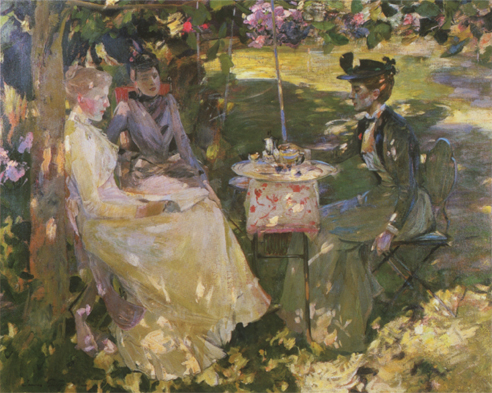
104 James Guthrie, Midsummer, 1892
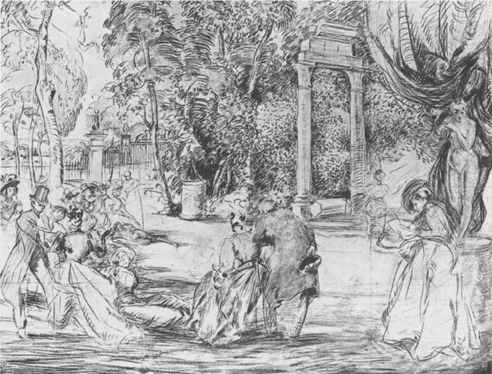
105 Henry Tonics, The Pastoral Play, 1899
Impressionist landscape was only partially successful. As a concept, the envelope of space, light and atmosphere depended heavily upon his reading of l’Art du dixhuitième siècle. In Guthrie, Moore had discovered the 1890s equivalent of Boucher’s ‘little plot of ground, singing and trembling with fresh colour full of bursting foliage, encumbered with complex tree forms … the verdant alfresco chamber of which the eighteenth century dreamt in its moments of tender fancy and bucolic yearning’.20 Elsewhere Moore was looking for ‘enchantment’, a code word for the qualities found in Watteau’s and Boucher’s landscapes, and in the 1890s, less and less appropriate to those of Monet.21
Guthrie’s painting opens up the way to tendencies which would become evident later. It was the path which Lavery literally retraced when he returned to the banks of the Loing in 1897, to paint A Garden in France. It is almost as though, in travelling back to the southern edge of the Fontainebleau, the painter was retreating to a lost domain. Twenty years earlier, Robert Louis Stevenson’s musings on these aromatic woods – ‘as though court ladies … still walked in summer evenings, and shed, from their fine brocades, a breath of musk and bergamot’ – must have seemed at the time like the caprice of a literary man.22 Now amid the scents and sounds of the dense overgrown garden at Marlotte there was the possibility that those presences might reappear. A Garden in France is no orthodox piece of Impressionism. In it the foliage encloses the figures, to the extent that the viewer almost loses his or her footing, in relation to the ground plane of the picture. The space can be read as there or here, at a distance or close by; it is disconnected, with no single set of referents, but many.23 The painter has not permitted a single organizing intelligence to rule his hand, but risks unity for multi-layering. The flowers grow up from around the feet of the viewer who is obliged to look through and beyond them to a scene which will for ever be a series of fragments. Only the flow of the river beyond restores continuity to the picture plane.
The sense of the breaking into pieces of the visual field and its recomposition with the aid of the art of the past is suggested by the anonymous visitor to Whistler’s house in Paris. Waiting for the painter to arrive, the writer looked out upon the garden, for which the decorative scheme of the room had been designed, noted ‘patches of daintiest green … with masses of pink flowers’ and then tried to remember if there was a latticed porch, a sundial or if the surrounding buildings were domestic or ecclesiastic, ‘you cannot remember afterwards, for the effect is so complete that the impression which lingers comes back to your memory like a panel by Watteau … a bit of nature trained to accord with the courtesy of urban need’.24
This alternative way of thinking, hinted at in Guthrie and Lavery, not directed towards mimesis, or even the mere reading of surface à la Monet, had captured Moore’s imagination. His enthusiasm for the prints of Utamaro was precisely because they were non-naturalistic.25 He was now interested in a different kind of authenticity in the search for those objects or fragments of an everyday experience which might initiate reverie or provoke imaginings. Through the memory of the configuration of the trees and the green sward, St James’s Park becomes Watteau’s parc. The visual correlative of this ‘enchantment’, frequently likened to Monticelli, Boucher and Watteau, and occasionally Gainsborough in the same breath, is found in the later 1890s work of Henry Tonks, Philip Wilson Steer and Charles Conder. Looking back on Steer’s work in 1909, C. H. Collins Baker’s most frequent citation was that of Watteau.26 The same author, the following year, remarked upon Tonks’s reliance on Watteau in his teaching of drawing. This is supported by evidence not only from students but from Tonks’s own strained efforts at ‘park’ subjects.27 The Pastoral Play, 1899 (Fig. 105), adds drapery, statuary and classical columns to Lavery’s and Guthrie’s props. Male flaneurs now engage the fashionable women in Wildean dialogue.28
For Steer’s and Conder’s patrons French eighteenth-century art was not simply a momentarily fashionable trend and, given the incipient nationalism which underwrote contemporary notions of Englishness and the fluctuations in Anglo-French relations at the time, it is, on the surface at least, difficult to account for. The diversity in late Victorian and Edwardian attitudes from the Franco-Prussian War onwards was characterized by the fact that the court at Windsor supported Germany while that at Marlborough House was decidedly Francophile. Relations between France and Britain had cooled during the Dreyfus Affair, came to the point of sabre-rattling as a result of the ‘Fashoda’ incident in 1898 and the Boer War, and warmed with the entente cordiale in 1903. Despite international politicking, in manners, dress and interior design there was a curious reciprocity.29 The ancien régime was perceived as a period of frivolity and overindulgence which resulted deservedly in revolution. Edwardian social commentators inherited their tone of moral disapproval for pre-Revolutionary France from Thomas Carlyle. With Baroness Orczy’s The Scarlet Pimpernel topping the best-seller list in 1905, eighteenth-century aristocracy was shamelessly caricatured in the context of familiar racial stereotypes and the revolutionaries of 1789 were portrayed as scoundrels. Revolution in Britain, despite the growth of anarchist, suffragist and labour groups, coupled with the intemperance of a vulgarian monarch after 1901, remained unthinkable.
These social and political issues were disassociated from the discussion of absolute aesthetic values. In the rarefied world of aesthetic theory, which did not significantly attack the concept of stylistic change in relation to the broader social and political cross-currents, Germanic thinking dominated.30 Meier-Graefe, perhaps tainted by German chauvinism, commented upon the incapacity of France and Britain to produce general systems of aesthetics. Referring to French artists’ lack of morality, with the exception of Zola’s stand on l’Affaire Dreyfus, he asserted the strong anti-intellectual current in French artistic discourse and concluded that
this is the reason why French art is great and French general aesthetics as a rule beneath contempt. The taste which displays its inimitable nobility and its inexorable logic in the works of the French School, becomes a sort of faint-hearted compromise the moment that it attempts to deal with anything but a work of art.31
These were, nevertheless, years which saw the ascendancy of French taste among the new plutocracy in Britain, identified with the monarch. The King’s Jewish friends, portrayed by Sargent, have collected the impediments of elegance. Thus, for instance, when the cultivated Mine de Rothschild married Edward Sassoon and eventually acquired 25 Park Lane as her London home, the house was remodelled with elegant rooms decked in boiseries, French furniture and Chinese porcelain.32 Inevitably the architectural restrictions imposed by Régence mouldings led to fewer, smaller pictures being displayed and these, in the case of the nouveaux riches, were often selected to obscure dubious origins or suggest a distinguished patriarchy. From these accoutrements emerged a thoughtless confidence which their original eighteenth-century makers did not betray. Regarding the work of Wilfrid de Glehn, an artist of German background working in England, T. Martin Wood noted that the painter of the present had found a ‘light-hearted note … instead of the concealed depression which is the characteristic of the laughter and music in a Watteau’. He continued, ‘Eighteenth century people, trying to keep their illusions, feared everything; twentieth century people, having parted with all theirs fear nothing. Eighteenth century people seeking happiness found a revolution, twentieth century people giving up the search are found by happiness.’33 Hedonists are justified providing they do not delude themselves. Artists like de Glehn saw no approaching storm.
The spectre of revolution or war did not cast a shadow over the Edwardian painters’ world, and on the level of the visual they tended not to segregate their sources systematically. Thus, for instance, George Clausen, writing to MacColl in 1943 with information for his forthcoming biography of Steer, generalized about the influences of Watteau and Gainsborough.34 Gainsborough was different from Watteau, but Steer might move easily between the two. Writing about Steer’s first solo exhibition at the Goupil Gallery in 1894, Moore characterized the decision-making process as a matter of the artist making up his mind to ‘use the trees, meadows, streams, and mountains before him as subject-matter for a decoration in the manner of the Japanese … or for the expression of a human emotion in the manner of Wilson and Millet’.35 At this point, the new guiding lights in Steer’s work had not become clear. Within a few years it became the case that he identified with those social elites which admired eighteenth-century culture and whose commissioning coincided with the entente cordiale. Evidence abounds for this current fashion. When Steer was asked to supply decorations for the drawing room of Cyril Butler’s house at Shrivenham he produced a set of grisailles of girls fishing, playing battledore and on a see-saw, to relieve wall panels of rose silk. The overmantle, Springtime (Fig. 106), a large canvas, 40 × 50 inches, was hailed as a masterpiece when the room was dismembered and the decorations sold in the 1930s.36 Oval over-doors and inserts were first stated as oil sketches before being worked up as trompe l’oeil re-creations of the delicate carvings of the eighteenth-century interior (Fig. 107).37
Steer was led in this direction by the example of Charles Conder, an artist who had first impressed Moore within a couple of months of that revelation in St James’s.38 Even at its early phase, it was evident to Moore that Conder’s work required special attention. He had arrived as an exhibitor in the New English Art Club at the very moment when public attention was diverted by the sale and subsequent exhibition of Degas’ l’Absinthe, and when, paradoxically, Moore’s artist contemporaries were turning away from visual appearances and from working on the motif. Sicken, in a rare moment of aberration, infected by Jacques-Emile Blanche’s dix-huitième enthusiasms, had converted the populace, strolling past l’Hotel Royal, Dieppe, into ladies with crinolines.39 Even Moore, normally one of his few supporters, was not entirely convinced by this, attempting lamely to justify these odd insertions as a way of filling up the dark-green foreground.40 Sickert’s influences at this point were as likely to have been drawn from eigh-teenth-century Venetian painting, from the Ridotto of Francesco Guardi, as much as from French sources.41 Aubrey Beardsley, in his only oil painting, A Caprice, done under Sickert’s tutelage at this time, adopts similar visual artifices.42
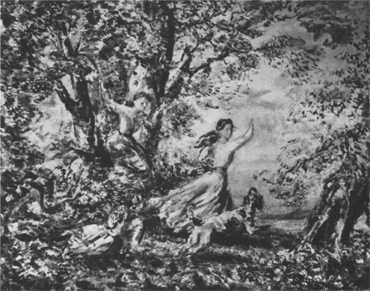
106 Philip Wilson Steer, Springtime, c. 19039:49 AM 6/23/2017
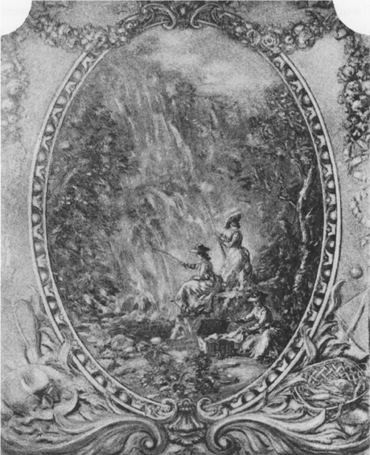
Sickert was, nevertheless, not much detained in eighteenth-century reverie. When Moore had been nervous about his new departure he had, in the same breath, hailed Conder’s arrival as the quintessence of European decadence. ‘It is the painting of chlorosis,’ he wrote, ‘of consumption, of Bright’s disease, of every languid malady.’43 These were pictures which did not stop with nature, ‘Mr. Conder is very different from the gentlemen who paint Folkestone at low tide and Folkestone at high tide.’44 Considering what was available to Moore in 1893, these are extraordinary assertions.45 If he was looking for an artist who substituted the pleasures of artifice for the facts of nature, and he was unconvinced by Sickert’s solution, Moore had found his answer in Conder. Over the next few years Conder’s work became pale and substanceless. The enchantment of Chantemesle, which he first savoured as an Impressionist in the early 1890s, was revisited in a more nostalgic vein in 1898 when he compared the place to ‘Watteau’s happy island’.46 The Yellow Book, which first appeared in April 1894, and in which Conder eventually published several drawings, put words alongside these visual tendencies.47 He retreated to Browning’s Venice in A Toccata of Galuppi’s and to Mozart for the image of Donna Elvira. The choices were significant. Browning had allegorized the end of the Venetian state and a Francophile like Conder, if he thought about it, might well interpret the bungling and bad publicity of Fashoda and the Boer War as an anticipation of the end of Empire. The futile geometry of the toccata left nothing permanent ‘when the kissing had to stop’. By this token, Conder’s maidens, in the late oils, washed up on Towan Beach should have been gone by the end of the season.48 Amazingly they remained for six or seven years until excess of drugs and alcohol stifled their creator.
Conder’s patrons provoked him towards the re-creation of rococo elegance.49 In 1895 he was invited to decorate the boudoir in Siegfried Bing’s Maison de l’Art Nouveau, the results of which were apparently unsatisfactory because he was working to a deadline.50 When he supplied decorations for the villa of the sturdy Norwegian painter, Fritz Thaulow, it was with loose unstretched wall-hangings, banners of silk and canvas which contained elegant ladies in floral hats and billowing dresses.51 A small British coterie, now anxious to escape the claustrophobic chintzes of the modern English interior, came to Conder with commissions. His work, placed upon fashionable ephemera, upon fans and screens, had to be strenuously justified. MacColl, in an extraordinarily evocative article, defended his poetry against English philistinism – ‘by people so stern to their own feelings, so shy of the grace and vanity of life, it is improbable that Conder’s art should be very much liked’.52 Conder demanded that patrons discard their old furniture and refurbish their living rooms, just as Pater’s Watteau had done. One such was Edmund Davis who invited Conder to supply decorations for a bedroom and dressing room in his house in Lansdowne Road, Holland Park (Fig. 108).53 The result was a series of warm, golden roundels and oblong inserts depicting a lotus land of half-clothed nymphs which, when they were unveiled in 1905, resulted in an adulatory article by T. Martin Wood. In this once again Conder was compared to Watteau, a painter who ‘almost created the fashion of his time, so anxious was he to embody his fancies on the surface of whatever came to hand’.54 Wood’s Bergsonian attitude to the immediate surroundings of the patron was to claim that architecture, particularly domestic architecture, was no more than a series of backdrops, ‘set scenes in which the drama of life is acted out’.55 In essence, the interior fantasy was only completed by its inhabitants, whose life, in turn, was to be distilled into a series of single frames. The central task of Bergson’s Matière et mémoire, which appeared in Paris in 1896, was to theorize the relationship between the mechanisms of perception in the present and the pre-existent memory bank of images from the past – our own past as well as that deeper cultural past which is appropriated from others through works of art. As Silverman has shown, in his initial attack on this theme, in Essai sur les données immédiates de la conscience, 1889, the central core of his life’s work, Bergson took that artist as a paradigm case, as someone concerned to translate ideas into images and to operate by means of suggestion and inference.56 Conder’s decorations did not need to refer to any particular history or legend, they were ‘crowded with images, pictures and memories of faded things’, they were no more than suggestions, cues or prompts to an enactment. Functioning in the private space of the boudoir, they were extensions to the life of interior spaces. As with Watteau, they brought the garden into the bedroom – both secluded spaces reserved for dreams and lovemaking – and they worked subliminally, beyond the surface, placed partially bend the furniture, hanging loose, falling into shadow. They were thus part of the background and their reduced colouring, now even more faded, subordinated them to the mire-en-scène, unlike conventional oil paintings.57 They had no independent existence outside the scheme.
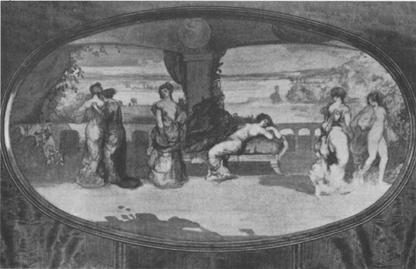
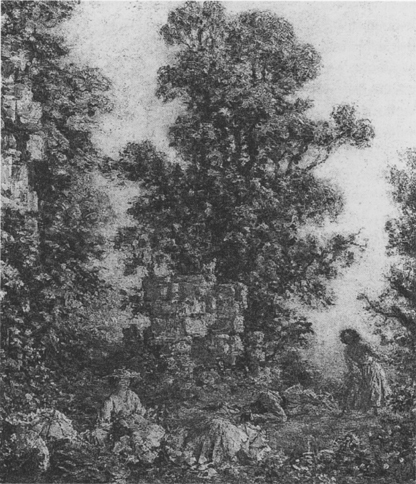
109 Philip Wilson Steer, The Picnic (Little Dean), 1909
In his return to the eighteenth century, Conder was seen by Wood to be looking to an age in which life was
lived as in itself an art – when the toilet was a high art, ministering to the beauty of fashion; when the pose taken up on a sofa, the gesture of saying goodbye, all formed part of an elaborate courteous science, when men and women lived not for any purpose, nor any duties or arts, except the art of giving themselves to a beautiful fantasy, as butterflies with gaiety float where the long sunbeams can play upon their coloured wings.58
Conder was attempting to achieve a general effect to which Davis could bring a multiplicity of readings. Where does that figure come from? That bridge vaguely recalls the Ponte Vecchio; that vista may be the Bay of Naples. These decorative panels were an invitation to sensual delight – a debauch in rosy tones containing hints of Claude, of Monticelli, echoes of the art of the Régence and the rococo, dreamily confected with the worlds of Florence and Venice in an eclectic mélange.
As Conder’s range reduced, Steer’s expanded. A St James’s Park revelation seems to occur every time he sits down to compose on the motif. Gainsborough, Turner, Constable, Watteau, Boucher, Monticelli, crowd around him and support the instinct of his painting arm. Ironside saw these landscapes of the late 1890s and beyond as an outpouring devoid of ‘the encroachments of intellect’.59 Holt has taken the grand panoramic pictures, those most heavily reliant upon British sources, to underscore an argument about the Edwardian remaking of a mythic vision of rural England.60 Steer’s work is more densely structured than these imply. When he attempted to put figures into his landscapes, the grand swathes of countryside, of noble trees and ruined forts, evaporated. His people were flimsy, fashionable and slightly effete. Far from being robust refashionings of the Dejuner sur l’herbe, the Summer Afternoon, 1899, and The Picnic (Little Dean), 1909 (Fig. 109), attempt to re-create the ‘verdant alfresco chamber’.61 They are prefigured in the Ludlow and Knaresborough landscapes of 1898. Prosaic questions about time and place, in considering The Embarkment, 1898, become irrelevant. Motif is subordinate to effect. In the heat of summer, under the lush heavy foliage at a clearing by the river, half a dozen revellers set off. The sense of dolce far niente appealed to John Singer Sargent, the first owner of the picture, in that it must have reminded him of their – his and Steer’s – common enthusiasm for the work of Adolphe Monticelli. Instinctively in this artist they had isolated a strand of modern painting which bore the traces of that earlier era. Monticelli’s teacher, Diaz de la Pena, of all the Barbizon School associates was the definitive translator for his time of the fête galante. Monticelli’s colours were woven in a tapestry-like effect which recalled the sketches made by painters of Boucher’s generation for the royal factories at Beauvais. Although he died in obscurity in 1886, his work appealed to those Glasgow and London dealers who were astute enough to anticipate a trend, and who cultivated Francophile collectors in Britain.62 In 1895, writing in The Art Journal, Marion Hepworth Dixon noted Monticelli’s popularity with Americans and Scots, describing his work as ‘an enchanted garden’ in which we might ‘breathe airs blown as from heavy laden flowers or the robes of some exquisite woman’.63 These were sentiments which were frequently repeated. A. E. (George Russell), for instance, described Monticelli’s paintings as containing
no recognizable trees, but there is the rich dark of the forest. There is no definite figure, but through a flutter of moth-like colour we catch a glimpse of a lovely face, a white arm or neck, a gracious movement of a body. It is enough to set us dreaming, where a more complete realization might have left us cold.64
Steer’s visual ambience was thus richer than is occasionally implied. He collected eighteenth-century porcelain and chinoiserie. His dining room was hung with engravings of the work of Watteau, Boucher, Lancret and Fragonard and he owned the recent publications about them.65 Although his effects, listed in his posthumous sale of 1942, have not been considered remarkable, taken with his legendary eccentricity and the tangled strands of his later work they help to recreate a personality which partially parallels that of the Goncourts, and can be likened specifically to their characterization of Boucher – someone who hesitated to leave his house and who was ‘surrounded by his own possessions and bibelots, that bouquet of enchanted colour, the glow and splendour of which has so often infused into his canvases’.66 For him, the Nidd flowing through Knaresborough was no ordinary river. It ran through the sunny pastures of northern France, out by a parched estuary on the southern shoreline and on to the happy island beyond the coast. As in Monticelli, there were no recognizable trees and no definite figures, but their shifting colour and fugitive, ‘moth-like’ movement left unmistakable traces. Ludlow Walks, 1898, was Watteau-like’ and illustrates a procession to Cythera, while to his room decorations, according to Collins Baker, Steer ‘brings a light and graceful inspiration, dixhuitième in mode, and in theme of what I might call the fête champêtre of today’.67 In the later Picnic, ‘enchantment’ translates as a group of young women enveloped in a rocky outcrop covered with indeterminate foliage, as though painted for the stage. Clad in flounces and carrying parasols, in the company of a single languorous male, they perform no ritual dance. Watteau’s commedia has succumbed to Edwardian mid-dle-class politesse. If the undergrowth could be cleared, food hampers would be discovered. Lived experience in Guthrie has been transformed into a congenial resolution of past and present in Steer.
Were these pictures merely pastiches – now of Watteau, now of Gainsborough? No, Springtime and The Picnic are not less authentic than Midsummer. They are the by-product of Steer’s particular fusion of matter and memory. It is clear, for instance, that Moore tested present reality against past experiences in front of works of art, and that for him, as for other European intellectuals, memory was conceived of as a series of images, like lantern slides in a projector. These could be called up when, as in St James’s, the occasion seemed to demand it. The artist of the 1890s, and Steer in particular, pictured himself as functioning in the same way; as thinking that this matter upon which he gazed was already part of his experience, and that he had seen it before, even though it had been created by someone else, in that bygone privileged world which he admired. Matter and memory were again brought to the point of fusion in works like Springtime, at the time when through Moore and others he had access in a general sense to shared opinions as to the functioning of the human brain.68 Bergson does not consider the presence in the mind of complete ready-made images supplied by the art of the past and accessible in museums, nor does he specifically address the degree to which this conditioning and the conscious cultivation of a visual memory in an art student might determine an artist’s production on the motif.69 However, the general view of perception, constrained by and responsive to present reality, yet carrying the codes of past experience, clearly equates with the practice of a painter whose present is indissolubly fused with remembrances of things past. Bergson wrote, ‘Our perceptions are undoubtedly interlaced with memories, and inversely, a memory … only becomes actual by borrowing the body of some perception into which it slips. These two acts, perception and recollection, always interpenetrate each other [sic], are always exchanging something of their substance as by a process of endosmosis.’70 Steer’s creative reaction was to work in a variety of manners, using thin fluid washes, scumbled impasto, scratching, bending and moulding the oil paint, each method understood and co-opted as he responded to the mental images which the landscape and its inhabitants suggested. He too might have walked through the park and his approximations in paint, his resolutions between what he saw and what he knew, revived and extended the phraseology of the gallant conversation.
Moore walked on through the park puzzling over Watteau and further along the path he was again brought to a halt, this time by ‘one of the loveliest Corots in the world’.71 For the writer who had fled from rural Ireland to obtain his education in the city, in Paris and London, the Corotesque landscape had come to occupy an equally special place in his affections. Corot exemplified the artist imbued with the ‘Greek’ spirit, who desired his work to be ‘merely beautiful’, and Moore’s passion for his work came as the result of direct experience.72 During his first year in France, the last year of Corot’s life, he had chanced upon the old painter working in the woods near Paris. He records that, looking over his shoulder, he could not at first decipher what Corot was painting, until he was told that the foreground only began 200 yards away, in what for most landscapists would be the middle distance. Corot did not paint everything before his eyes, but carefully selected his composition from what was available. He was the master of rhythmic line and ‘values’. An important distinction had to be made between his approach and those painters in the school of Monet who go for ‘dazzling and iridescent tints’ and who never learn ‘how to organize and control’ values.73 A walk through St James’s was enough to confirm his prejudices.
In singling out Corot, Moore was referring to a territory which was already familiar to his audience. His name immediately signalled a certain generality. If Watteau was a specialist taste at the beginning of the 1890s, this painter was a known commodity and collectors were discriminating in their preference for the later work.74 They stood with Sir Robert Chiltern in Oscar Wilde’s An Ideal Husband in 1893, in their preference for paintings of ‘silver twilights and rose-pink dawns’.75 Corot and the Barbizon School were clearly implicated in rustic naturalism, the very thing which Moore abhorred, and his work had been an inspiration to the more poetic visitors to Barbizon, Marlotte and Grez-sur-Loing.76 However, when Sir Robert invites Mrs Cheveley to see his Corots, she refuses: she is not ‘in the mood’. The visually literate were well familiar with his work. In this instance he had to be resisted. The memories which he called to mind were of a particular character, and, in effect, Corot’s interpretation of nature had overwritten them. He had supplied the definitive expression of a certain kind of reverie.
Aspects of Corot’s sensibility were picked up and repeated by the new school of British landscapists which included the likes of David Murray and Alfred East. Writing about East in 1895, Walter Armstrong began by quoting at length from a letter, recently published by D. C. Thomson, which Corot had written to one of his British admirers.77 It expressed the innocent joy of the landscapist working on the motif at sunrise and seeing the changes in nature as midday approached. ‘After lunch,’ the painter wrote, ‘I will dream my landscape and later on will paint it.’ Armstrong noted these ‘same procedures’ in East, a painter who ‘lay in wait for nature … accepting the impressions she gives, digesting them and then sallying forth to realise his dream, with the fact before him to prevent the dream becoming too dreamlike’ (Fig. 110).78 He was edgy about direct comparisons. ‘You may take your general notions of how a picture should look from someone else,’ he wrote, ‘but unless your work is literally traced from theirs, you must make a design for yourself which will stand or fall by its own coherence.’79 Moore was edgy too, but he refrained from mounting a defence of East.80 For the painter there were traps in a process which derived from observations recollected in tranquillity, ‘after lunch’. In fairness, East was also aware of the traps and would conventionally advise ever closer engagement with nature as the universal truth.’81
After seeing his ‘vision’ in St James’s Park in September 1893, Moore did not wait long for a painter who, in his terms, fulfilled Corot’s mission, in that he was looking at nature and beyond it. In the New English Art Club in the following November he saw what he described as the ‘Corot Conder’, in ‘a tint of green spread over the canvas in the shape of a bouquet of trees … Nature passes through his brain before it appears on canvas; only in doing so nature is so thoroughly exhausted that one feels there is very little hope of her ultimate recovery.’82 East’s nature was being challenged by a kind of Bergsonian relativism. Pictures were now, as never before, validated, not by recourse to real hills and trees, but by selective use of the art of the past. The painter was locking into a collective mentality, which permitted elements of pastiche in the cases of Steer, Conder, East and others. A scene encountered in daily life calls up a landscape derived from others and, as it forms in the mind, the original stimulus evaporates like morning mist in midday sun.
It was this composing and dissolving in the mind which Moore experienced in St James’s. He itemized the ingredients; the broken branch, the rose sky and the lake. But these London trees were heavier than those in Corot’s By the Side of the Water (Fig. 111), the broken branch did not fall across the foreground in the same way as that in Le lac de Garde and this sky lacked the ‘refined concentration’ of the sky in Ravine.83 Momentary aesthetic pleasure in nature’s gift did not compensate for what was, after all, only ‘a false Corot’. Distracting and disconcerting details began to appear. Children feeding a black swan were reproved by their mothers ‘for reasons which must always seem obscure to the bachelor’. Buckingham Palace in the distance provided a ‘good’ but ‘obvious’ line, and as he walked on he noticed that ‘the rose sky had turned to a cold crimson’. The Corot in St James’s Park had been ‘merely an abortive attempt on the part of Nature to rise to the great man’s level’.84 Whistler had taught Moore’s generation that the natural world was never good enough.85 Having slammed the followers of Bastien-Lepage for copying nature inch by inch, he was compelled to take the Whistlerian standpoint. Yet there was something more fundamental in this process by which Watteau and Corot were transformed and remade in St James’s. Pictures which may in themselves be approximations of the mentality which produced them fall into, are consumed by and become part of the mental equipment of the writer or the painter. They become part of an involuntary recall, mediating between present experience and pleasures felt in the company of works of art. For the moment Moore was involved in a frantic process of decoding. This bit reminded him of Ravine, that bit recalled the Lac de Garde. As they became clearer the half-remembered paintings did not match the changing scene. The moment had passed. It was over.
This was what Moore experienced in September 1893, if we believe it. Present circumstances were no more real than those recollected in a picture. It is entirely possible that he did not actually walk through St James’s, or if he did, that he did not think of Watteau or Corot at the time. This whole stream of connected images, the coster woman and child, the sylvan glade, the pathway, the black swan, might only ever have existed in the mind’s eye as he wrote. It is possible that he was merely describing a group of pictures, linked in a series of superimpositions, and that a journey like this, a walk to an eating house, was merely images which were in themselves only accessible to memory and desire.
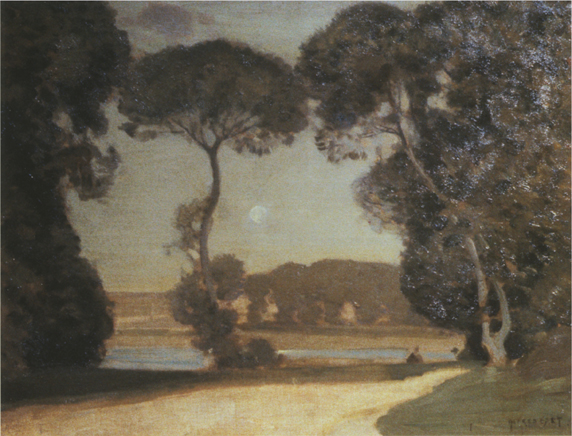
110 Alfred East, A Pastoral, c. 1900
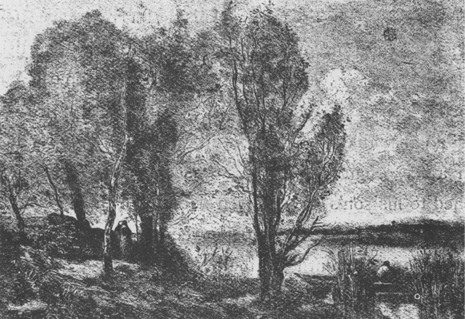
111 Jean-Baptiste-Camille Corot, By the Side of the Water, c. 1860
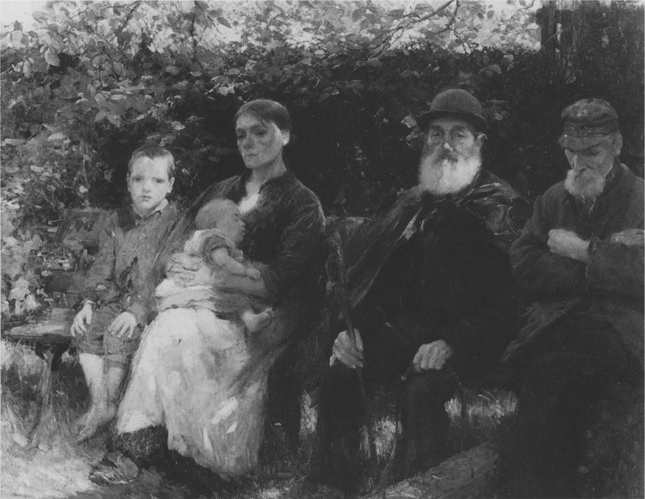
114 Walter Osborne, In a Dublin Park – Light and Shade, 1895